Powerwave Technologies 5JS0059 1900MHz CDMA Multi-Channel Amplifier User Manual I GENERAL DESCRIPTION
Powerwave Technologies Inc 1900MHz CDMA Multi-Channel Amplifier I GENERAL DESCRIPTION
User Manual

044-xxxxx Rev. x
INSTALLATION & SERVICE
MANUAL
MULTICHANNEL
POWER AMPLIFIER
NTGY81AC
1930-1990 MHz
50 WATTS AVERAGE POWER
04 April 2002
Powerwave Technologies, Inc. Tel: (714) 466-1000
1801 E. St. Andrew Place Fax: (714) 466-5800
Santa Ana, CA 92705 Web Site: www.powerwave.com
®

044-xxxxx Rev. x ii
TABLE OF CONTENTS
Par. Section 1 Page
No. General Description No.
1-1 Introduction..................................................................................................................... 1-1
1-2 General Description....................................................................................................... 1-1
1-3 Functional and Physical Specifications........................................................................... 1-1
Section 2
Installation
2-1 Introduction..................................................................................................................... 2-1
2-2 Electrical Service Recommendations............................................................................. 2-1
2-3 Unpacking and Inspection .............................................................................................. 2-1
2-4 Installation Instructions ................................................................................................... 2-2
2-5 +26 VDC Power and Ground Connector P1................................................................... 2-2
2-6 Alarms and Sensing Connector P2 ................................................................................ 2-3
2-7 Differential IIC Clock, Receive, and Transmit Connector P3.......................................... 2-4
2-8 IIC, Power, Alarms,and Controls Connector P4 ............................................................. 2-4
2-9 IIC, RS485, Power, and Other Signals Connector P5.................................................... 2-6
Section 3
Operating Instructions
3-1 Introduction..................................................................................................................... 3-1
3-2 Initial Start-Up and Operating Procedures...................................................................... 3-1
Section 4
Principles of Operation
4-1 Introduction..................................................................................................................... 4-1
4-2 RF Input Signal............................................................................................................... 4-1
4-3 RF Output Load.............................................................................................................. 4-1
4-4 Amplifier Functional Description..................................................................................... 4-1
4-4.1 Input Amplifier................................................................................................................. 4-1
4-4.2 Predistortion Amplifier ....................................................................................................4-1
4-4.3 Driver Amplifier ............................................................................................................... 4-2
4-4.4 Main Amplifier................................................................................................................. 4-2
4-4.5 Multifunction Board......................................................................................................... 4-2
4-5 Amplifier Module Cooling................................................................................................ 4-2
4-5 Power Distribution...........................................................................................................4-2

044-xxxxx Rev. x iii
TABLE OF CONTENTS (Continued)
Par. Section 5 Page
No. Maintenance No.
5-1 Introduction..................................................................................................................... 5-1
5-2 Periodic Maintenance ..................................................................................................... 5-1
5-3 Test Equipment Required For Test ................................................................................ 5-1
5-4 Performance Test........................................................................................................... 5-2
5-4.1 Amplifier Performance Test............................................................................................ 5-2
5-5 Field Replacement of the Module................................................................................... 5-5
Section 6
Troubleshooting
6-1 Introduction.......................................................................................................................6-1
6-2 Troubleshooting................................................................................................................6-1
6-3 Return for Service Procedures .........................................................................................6-1
6-3.1 Obtaining an RMA ............................................................................................................6-1
6-3.2 Repackaging for Shipment ...............................................................................................6-1
LIST OF ILLUSTRATIONS
Figure Page
No. No.
1-1 NTGY81AC Multichannel Power Amplifier ..................................................................... 1-3
2-1 +26 Vdc Power and Ground Connector P1 .................................................................... 2-2
2-2 Alarms and Sensing Connector P2 ................................................................................ 2-3
2-3 Differential IIC Clock, Receive, and Transmit Connector P3.......................................... 2-4
2-4 IIC, Power, Alarms, and Controls Connector P4 ............................................................ 2-4
2-5 IIC, RS485, Power and Other Connector P5.................................................................. 2-6
4-1 NTGY81AC Multichannel Power Amplifier Functional Block Diagram ........................... 4-2
5-1 NTGY81AC Amplifier Test Setup Diagram .................................................................... 5-3
LIST OF TABLES
Table Page
No. No.
1-1 NTGY81AC Multichannel Power Amplifier Functional Specifications..... ....................... 1-2
2-1 +26 Vdc Power and Ground Connector P1 Definition .................................................... 2-2
2-2 Alarms and Sensing Connector P2 Definition ................................................................ 2-3
2-3 Differential IIC Clock, Receive, and Transmit Connector P3 Definition.......................... 2-4
2-4 IIC, Power, Alarms, and Controls Connector P4 Definition ............................................ 2-5
2-5 IIC, RS485, Power and Other Connector P5 Definition.................................................. 2-6
5-1 Periodic Maintenance ..................................................................................................... 5-1
5-2 Test Equipment Required............................................................................................... 5-2
5-3 Multichannel Power Amplifier NTGY81AC Test Data Sheet .......................................... 5-4
6-1 Troubleshooting..............................................................................................................6-1

044-xxxxx Rev. x 1-1
GENERAL DESCRIPTION
1-1. INTRODUCTION
This manual contains information and procedures for installation, operation, and maintenance of
Powerwave’s model NTGY81AC multichannel power amplifier (MCPA). The manual is organized
into six sections as follows:
Section 1. General Description
Section 2. Installation
Section 3. Operating Instructions
Section 4. Principles of Operation
Section 5. Maintenance
Section 6: Troubleshooting
1-2. GENERAL DESCRIPTION
The NTGY81AC is a linear, multichannel power amplifier that operates in the 60 MHz frequency
band from 1930 MHz to 1990 MHz. It is designed to be mounted in an enclosure with EMI
containment. Its flat base plate allows for mounting on a flat thermal-absorbing surface to provide
adequate heat dissipation.
Each amplifier module has a power, alarm, and control connector that allows the host system to
monitor the amplifier module performance. Primary power for the amplifier is +26 Vdc.
1-3. FUNCTIONAL AND PHYSICAL SPECIFICATIONS
Functional and physical specifications for the amplifier are listed in table 1-1.
Section
1

044-xxxxx Rev. x 1-2
Table 1-1. NTGY81AC Multichannel Power Amplifier Functional Specifications
Frequency Range 1930-1990 MHz (60 MHz Bandwidth)
Maximum Average Input Power 13 dBm
Continuous Average Output Power 50 Watts
Spurious Emissions @ Maximum
Rated Output Power
(50 W / 47 dBm)
Frequency Offset Requirement Meas. Bandwidth
Max. Min.
0.885-1.25 MHz -47 dBc 30 kHz
1.25-1.98 MHz -16.5 dBm 37.5 kHz
1.98-2.25 MHz -58 dBc 30 kHz
>2.25 MHz -15 dBm 1 MHz
RF Gain 47 ±2 dB
Gain Flatness: ± 0.2 dB for any 1.25-MHz band within frequency range.
Output Protection: Mismatch Protected
Input Port Return Loss: VSWR 2:1 Max.
Out of Band Spurious: Less than -15 dBm / 1 MHz
DC Input Power: +26 ± 0.5 Vdc, 260 mV p-p max. ripple, ≤500 watts
Operating Temperature: -15 ºC. to +85 ºC. (heatsink temperature)
Storage Temperature: -40 ºC. to +85 ºC.
Operating Humidity: 5 % - 95 % Relative Humidity (Noncondensing)
Storage Humidity: 5 % - 95 % Relative Humidity (Noncondensing)
Interface Connectors:
RF Input-----------------------------------
RF Output --------------------------------
+26 Vdc Power and Ground ---------
Alarms and Sensing -------------------
Differential IIC Clock, Rcv., Xmit.---
IIC, Power, Alarms, Controls---------
IIC, RS485, Power, Other Signals --
SMA Female
SMA Female
3W3 D-Sub (Connector P1)
14-Position Micro-Fit 3.0 (Connector P2)
6-Position Micro-Fit 3.0 (Connector P3)
26-Position High Density D-Sub (Connector P4)
18-Position Micro-Fit 3.0 (Connector P5)
Dimensions (inches): 11.00 x 14.50; height: 1.70
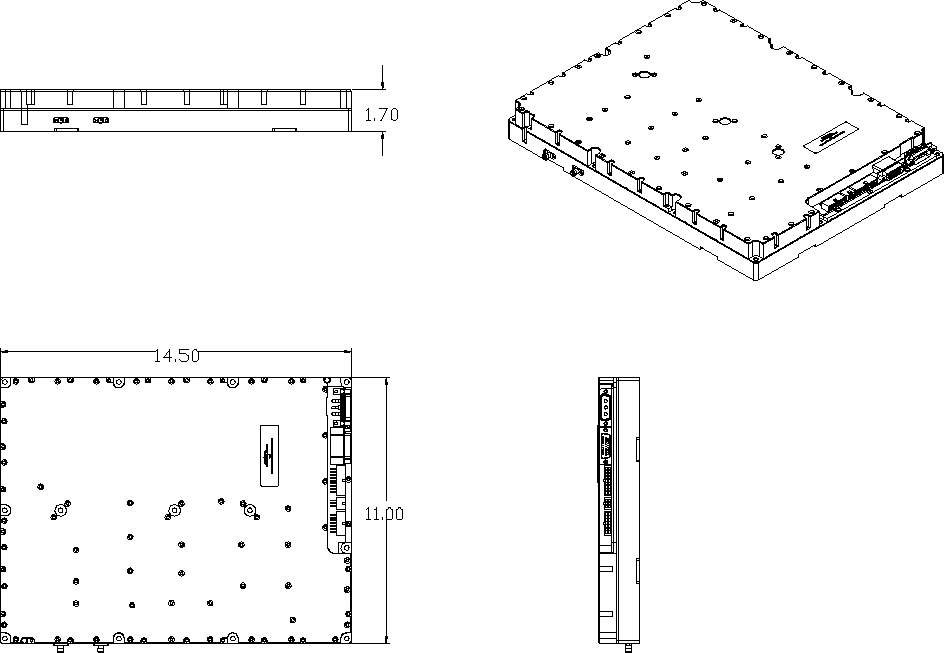
044-xxxxx Rev. x 1-3
P1
P4
P5
P3
P2
RF OUT RF IN
Figure 1-1. NTGY81AC Multichannel Power Amplifier

044-xxxxx Rev. x 2-1
INSTALLATION
2-1. INTRODUCTION
This section contains unpacking, inspection, and installation instructions and recommendations
for the Model NTGY81AC Multi Channel Power Amplifier. Carefully read all material in this
section prior to equipment unpacking or installation. Also read and review the operating
procedures in Section 3 prior to installing the equipment. It is important that the licensee perform
these tasks correctly and in good faith. If applicable, carefully read the appropriate parts of the
Federal Communications Commission (FCC) rules to determine how they apply to your
installation. DON'T TAKE CHANCES WITH YOUR LICENSE.
2-2. ELECTRICAL SERVICE RECOMMENDATIONS
Powerwave Technologies recommends that proper AC line conditioning and surge suppression
be provided on the primary AC input to the +26 Vdc power source. All electrical service should be
installed in accordance with the National Electrical Code, any applicable state or local codes, and
good engineering practice. Special consideration should be given to lightning protection of all
systems in view of the vulnerability of most transmitter sites to lightning. Lightning arrestors are
recommended in the service entrance. Straight, short ground runs are recommended. The
electrical service must be well grounded.
Each amplifier system should have its own circuit breaker, so a failure in one does not shut off the
whole installation. Circuit breakers should be thermal type, capable of handling the maximum
anticipated inrush current, in a load center with a master switch.
2-3. UNPACKING AND INSPECTION
This equipment has been operated, tested and calibrated at the factory. Carefully open the
container(s) and remove the amplifier module(s). Retain all packing material that can be
reassembled in the event that the unit must be returned to the factory.
CAUTION
Exercise care in handling equipment
during inspection to prevent damage
caused by rough or careless handling.
Visually inspect the amplifier module for damage that may have occurred during shipment. Check
for evidence of water damage, bent or warped chassis, loose screws or nuts, or extraneous
packing material in the connector. If the equipment is damaged, a claim should be filed with the
carrier once the extent of any damage is assessed. We cannot stress too strongly the importance
of IMMEDIATE careful inspection of the equipment and the subsequent IMMEDIATE filing of the
necessary claims against the carrier if necessary. If possible, inspect the equipment in the
presence of the delivery person. If the equipment is damaged, the carrier is your first area of
recourse. If the equipment is damaged and must be returned to the factory, write or phone for a
return authorization. Powerwave may not accept returns without a return authorization. Claims
for loss or damage may not be withheld from any payment to Powerwave, nor may any payment
due be withheld pending the outcome thereof. WE CANNOT GUARANTEE THE FREIGHT
CARRIER'S PERFORMANCE
Section
2
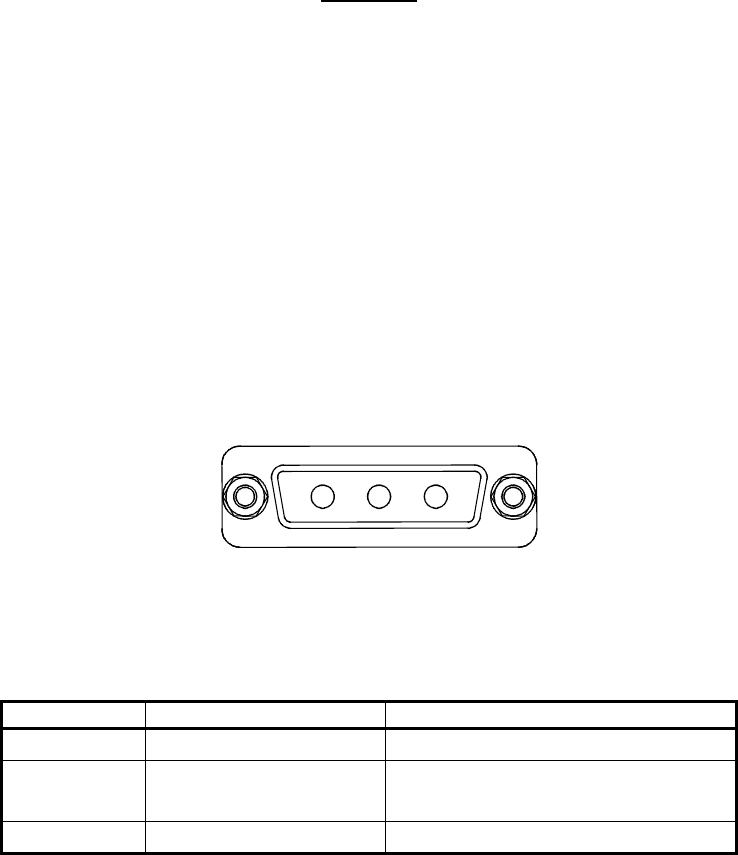
044-xxxxx Rev. x 2-2
2-4. INSTALLATION INSTRUCTIONS (Refer to figure 1-1)
The NTGY81AC amplifier module is designed for installation on a heatsink that permits access to
the module for connection of RF cables and the power, alarm, and control connector.
To install the amplifier proceed as follows:
1. Install amplifier on heatsink with thermally conductive material inserted between amplifier
module and heatsink, and secure in place with appropriate mounting screws.
2. Connect the antenna cable to RF OUT female SMA connector.
3. Connect the transceiver output cable to RF IN frmale SMA connector.
WARNING
Turn off external primary DC power
before connecting any cables.
4. Connect power, alarm, and control cables to matching P1 through P5 connectors. Refer to
paragraphs 2-5 through 2-9 following.
6. Check your work before applying DC voltage to the system. Make certain all connections are
tight and correct.
7. Measure primary DC input voltage. DC input voltage should be +26 ±0.5 Vdc. If the DC input
voltage is above or below the limits, call and consult Powerwave before you turn on your
amplifier system.
8. Refer to section 3 for initial turn-on and checkout procedures.
2-5. +26 VDC POWER AND GROUND CONNECTOR P1
The +26 Vdc power and ground connections on the amplifier are made through an 3-pin female
D-Sub connector (figure 2-1) and are listed and described in table 2-1.
321
Figure 2-1. +26 Vdc Power and Ground Connector P1
Table 2-1. +26 Vdc Power and Ground Connector P1 Definition
PIN SIGNAL DESCRIPTION
1 +26V +26 Vdc for MCPA
2 +26V_RTN +26 Vdc return, grounded to MCPA
chassis ground.
3 Chassis Gnd. Chassis Ground
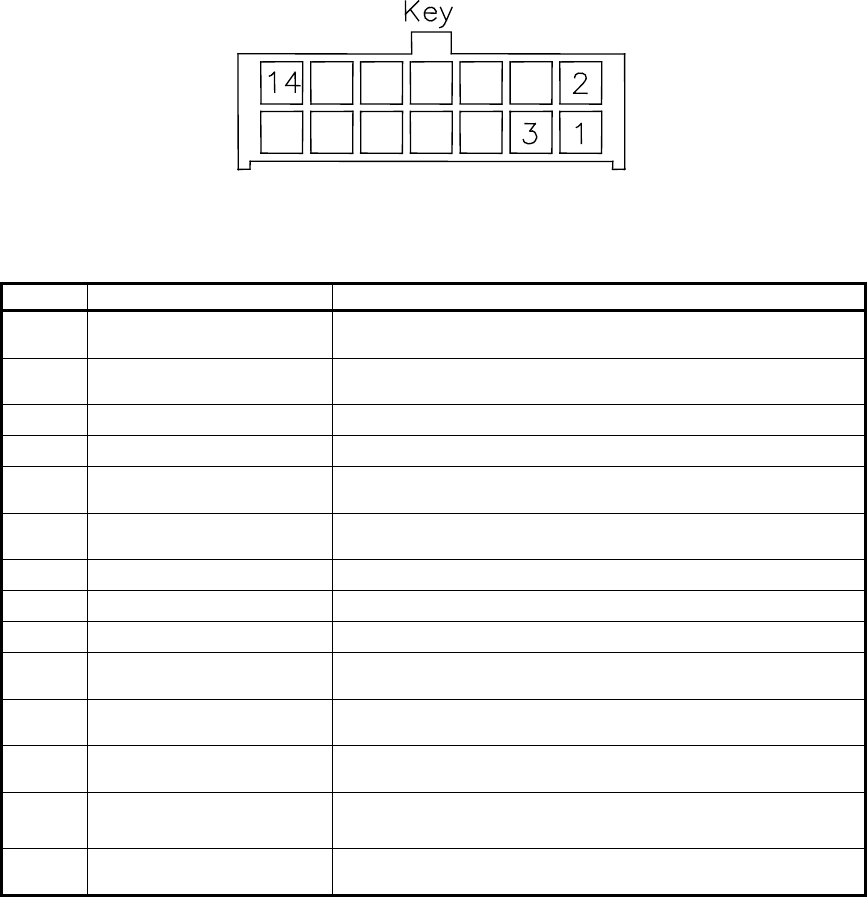
044-xxxxx Rev. x 2-3
2-6. ALARMS AND SENSING CONNECTOR P2
The alarms and sensing connections on the amplifier are made through a 14-pin micro-fit
connector (figure 2-2) and are listed and described in table 2-2.
Figure 2-2. Alarms and Sensing Connector P2
Table 2-2. Alarms and Sensing Connector P2 Definition
PIN SIGNAL DESCRIPTION
1 +5V_AIM 5-volt supply for the AIM; routed directly to the fan
assembly / AIM connector
2 +5V_AIM_RTN 5-volt supply return for the AIM; routed directly to the fan
assembly / AIM connector
3 +26V_ALARM 26V HPCA alarm input
4 +15V_ALARM 15V HPCA alarm input
5 REMOTE_SENSE Remote sense for HPCA; connected directly to 26V
supply
6 REMOTE_SENSE_RTN Remote sense return for HPCA; connected directly to 26V
supply return
7 +5V_ALARM 5V HPCA alarm input
8 NC Not connected
9 26ARTN 26V alarm return connected to 26V return on the MCPA
10 ARTN 5V and 15V alarm return connected to 26V return on the
MCPA
11 +26V_FAN 26V supply for the fans; routed to fan assembly / AIM
connector
12 +26V_FAN_RTN 26V supply return for the fans; routed to fan assembly /
AIM connector
13 +26V_FAN 26V supply for the fans; routed to fan assembly
/ AIM connector
14 +26V_FAN_RTN 26V supply return for the fans; routed to fan assembly /
AIM connector
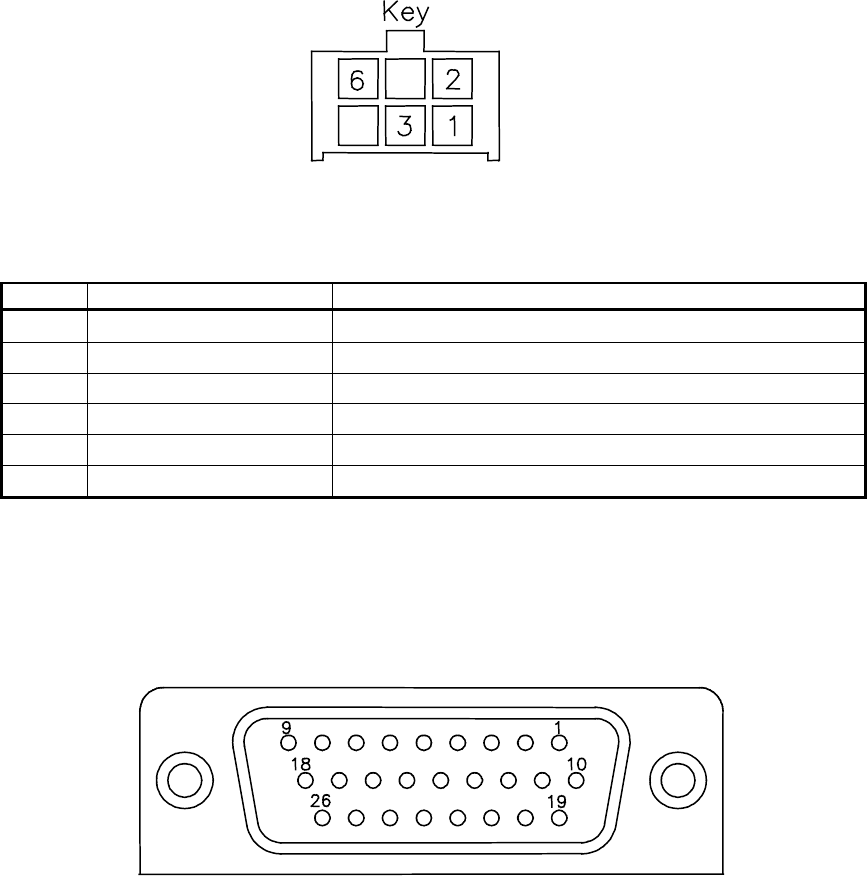
044-xxxxx Rev. x 2-4
2-7. DIFFERENTIAL IIC CLOCK, RECEIVE, AND TRANSMIT CONNECTOR P3
The alarms and sensing connections on the amplifier are made through a 6-pin micro-fit
connector (figure 2-3) and are listed and described in table 2-3.
Figure 2-3. Differential IIC Clock, Receive, and Transmit Connector P3
Table 2-3. Differential IIC Clock, Receive, and Transmit Connector P3 Definition
PIN SIGNAL DESCRIPTION
1 IIC_CLK+ Differential IIC Clock to the DPM
2 IIC_CLK- Differential IIC Clock to the DPM
3 IIC_RX_DATA+ Differential IIC Receive Data (from DPM)
4 IIC_RX_DATA- Differential IIC Receive Data (from DPM)
5 IIC_TX_DATA+ Differential IIC Transmit Data (to DPM)
6 IIC_TX_DATA- Differential IIC Transmit Data (to DPM)
2-8. IIC, POWER, ALARMS, AND CONTROLS CONNECTOR P4
The alarms and sensing connections on the amplifier are made through a 26-pin high density
D-Sub connector (figure 2-4) and are listed and described in table 2-4.
Figure 2-4. IIC, Power, Alarms, and Controls Connector P4

044-xxxxx Rev. x 2-5
Table 2-4. IIC, Power, Alarms, and Controls Connector P4 Definition
PIN SIGNAL DESCRIPTION
1 +26_FAN 26V supply to the fans; routed from 12-position HPCA
connector
2 +26_FAN_RTN 26V supply returnto the fans; routed from 12-position
HPCA connector
3 FAN_ALARM1 Alarm for one of three fans in fan assembly / AIM.
Generated by the fan assembly / AIM and sent to the
MFRM via the MCPA’s RS485 link.
4 FAN_ALARM2 Alarm for one of three fans in fan assembly / AIM.
Generated by the fan assembly / AIM and sent to the
MFRM via the MCPA’s RS485 link.
5 FAN_ALARM3 Alarm for one of three fans in fan assembly / AIM.
Generated by the fan assembly / AIM and sent to the
MFRM via the MCPA’s RS485 link.
6 AUX_ALARM+ Analog voltage signal that is generated from either an
external power combiner or an intrusion alarm
mechanism, passed to the MFRM through the RS485.
7 AUX_ALARM- Analog voltage signal that is generated from either an
external power combiner or an intrusion alarm
mechanism, passed to the MFRM through the RS485.
8 AUX_CTRL1 Contact closure switch on the MCPA but controlled by the
MFRM software. Default status is OPEN upon power up
and CLOSED on power down conditions.
9 AUX_CTRL2 Contact closure switch on the MCPA but controlled by the
MFRM software. Default status is OPEN upon power up
and CLOSED on power down conditions.
10 +5V_AIM_RTN 5V supply return for the AIM. Comes from the HPCA via
connector P2 and routed through MCPA.
11 +5V_AIM 5
5V
V
s
su
up
pp
pl
ly
y
f
fo
or
r
t
th
he
e
A
AI
IM
M.
.
C
Co
om
me
es
s
f
fr
ro
om
m
t
th
he
e
H
HP
PC
CA
A
v
vi
ia
a
c
co
on
nn
ne
ec
ct
to
or
r
P
P2
2
a
an
nd
d
r
ro
ou
ut
te
ed
d
t
th
hr
ro
ou
ug
gh
h
M
MC
CP
PA
A
12 IIC_CLK+ Differential IIC clock to the fan assembly / AIM
13 IIC_CLK- Differential IIC clock to the fan assembly / AIM
14 IIC_RX_DATA+ Differential IIC receive data (from fan assembly / AIM)
15 IIC_RX_DATA- Differential IIC receive data (from fan assembly / AIM)
16 IIC_TX_DATA+ Differential IIC transmit data (to fan assembly / AIM)
17 IIC_TX_DATA- Differential IIC transmit data (to fan assembly / AIM)
18 FORCE_ON+ Routed directly from MTRM connector; turns on LEDs (in
the AIM) during power-up sequence.
19 FORCE_ON- Routed directly from MTRM connector; turns on LEDs (in
the AIM) during power-up sequence.
20 +26V_FAN 26V supply for the fans from (HPCA) connector P2
21 +26V_FAN_RTN 26V supply return for the fans from (HPCA) connector P2
22-26 NC Not connected

044-xxxxx Rev. x 2-6
2-9. IIC, RS485, POWER, AND OTHER SIGNALS CONNECTOR P5
The alarms and sensing connections on the amplifier are made through a 18-pin micro-fit
connector (figure 2-5) and are listed and described in table 2-5.
Figure 2-5. IIC, RS485, Power, and Other Signals Connector P5
Table 2-5. IIC, RS485, Power, and Other Signals Connector P5 Definition
PIN SIGNAL DESCRIPTION
1 FORCE_ON+ Turns on LEDs (in the AIM) during power up sequence;
routed directly from MTRM connector to fan assembly /
AIM connector
2 FORCE_ON- Turns on LEDs (in the AIM) during power up sequence;
routed directly from MTRM connector to fan assembly /
AIM connector
3 +ALLOW_HPA_ENABLE Enables MCPA when high. Requires enable command
via RS485 and HW_ENABLE high impedance to ground
and no shutdown conditions exist.
4 -ALLOW_HPA_ENABLE Enables MCPA when high. Requires enable command
via RS485 and HW_ENABLE high impedance to ground
and no shutdown conditions exist.
5 MCPA_TX+ Differential RS485 link to MTRM
6 MCPA_TX- Differential RS485 link to MTRM
7 MCPA_RX+ Differential RS485 link from MTRM
8 MCPA_RX- Differential RS485 link from MTRM
9 IIC_CLK+ Differential IIC clock from MTRM
10 IIC_CLK- D
Di
if
ff
fe
er
re
en
nt
ti
ia
al
l
I
II
IC
C
c
cl
lo
oc
ck
k
f
fr
ro
om
m
M
MT
TR
RM
M
11 IIC_RX_DATA+ D
Di
if
ff
fe
er
re
en
nt
ti
ia
al
l
I
II
IC
C
r
re
ec
ce
ei
iv
ve
e
d
da
at
ta
a
(
(f
fr
ro
om
m
M
MT
TR
RM
M)
)
12 IIC_RX_DATA- D
Di
if
ff
fe
er
re
en
nt
ti
ia
al
l
I
II
IC
C
r
re
ec
ce
ei
iv
ve
e
d
da
at
ta
a
(
(f
fr
ro
om
m
M
MT
TR
RM
M)
)
13 IIC_TX_DATA+ D
Di
if
ff
fe
er
re
en
nt
ti
ia
al
l
I
II
IC
C
t
tr
ra
an
ns
sm
mi
it
t
d
da
at
ta
a
(
(t
to
o
M
MT
TR
RM
M)
)
14 IIC_TX_DATA- D
Di
if
ff
fe
er
re
en
nt
ti
ia
al
l
I
II
IC
C
t
tr
ra
an
ns
sm
mi
it
t
d
da
at
ta
a
(
(t
to
o
M
MT
TR
RM
M)
)
15 +5V_DC_IN +5V supply voltage for the IIC circuit on MCPA; not used
in any other circuits.
16 +5V_DC_RTN +5V supply voltage return for the IIC circuit on MCPA; not
used in any other circuits.
17 CABLE_DETECT
Cable detect line connected to GPI/O port of MTRM
microprocessor. Pulled high via +5V_DC_IN; connected
to reset pin on microcontroller to allow MTRM reset if
necessary.
18 HW_ENABLE Hardware enable signal. MCPA enabled when shorted to
chassis ground.

044-xxxxx Rev. x 3-1
OPERATING INSTRUCTIONS
3-1. INTRODUCTION
This section contains operating instructions for the Multicarrier Cellular Amplifier.
3-2. INITIAL START-UP AND OPERATING PROCEDURES
There are no operating controls or indicators on the NTGY81AC amplifier module. To perform the
initial start-up, proceed as follows:
1. Double check to ensure that all input and output cables are properly connected.
CAUTION
Before applying power, make sure that the input and output of the
amplifier are properly terminated at 50 ohms. Do not operate the
amplifier without a load attached. Refer to table 1-1 for input power
requirements. Excessive input power may damage the amplifier
NOTE
The output coaxial cable between the amplifier and the antenna must
be 50 ohm coaxial cable. Use of any other cable will distort the output.
2. Turn on supply that provides +26 Vdc to the amplifier system.
3. Turn on external exciter/transceiver and apply RF input signals.
Section
3

044-xxxxx Rev. x 4-1
PRINCIPLES OF OPERATION
4-1. INTRODUCTION
This section contains a functional description of the multichannel power amplifier (MCPA).
4-2. RF INPUT SIGNAL
The maximum input power should not exceed the limits specified in table 1-1.
4-3. RF OUTPUT LOAD
The load impedance should be as good as possible (1.5:1 or better) in the working band for good
power transfer to the load.
4-4. AMPLIFIER FUNCTIONAL DESCRIPTION
The NTGY81AC amplifier (figures 1-1 and 4-1) is a linear, multichannel power amplifier that
operates in the 60 MHz frequency band from 1930 MHz to 1990 MHz at an output power of 50
watts. Each amplifier is a self-contained module and is functionally independent of any other
amplifier modules in the system. Each amplifier module has an alarm board that monitors the
amplifier performance. If a failure or fault occurs in an amplifier module, it is transmitted to the
host system via an RS485 interface.
The amplifier is compliant to the requirements of FCC Part 24 with respect to spurious emissions
(see table 1-1). Constant gain is maintained by continuously comparing active paths with passive
references, and correcting for small variations through the RF feedback controls. All gain
variations, for example those due to temperature, are reduced to the passive reference variations.
The amplifier module is comprised of:
An input amplifier
A predistortion amplifier
A driver amplifier
A main amplifier
A multifunction board
4-4.1. INPUT AMPLIFIER
RF is fed to the input amplifier, which consists of an isolator at the input, bandpass filter, VVAs,
and phase shifters for gain control and phase sweeping functions. They are controlled by a
microprocessor on the multifunction board. At its output, the input amplifier splits the signal to the
predistortion amplifier and carrier cancellation circuits.
4-4.2. PREDISTORTION AMPLIFIER
The predistortion amplifier predistorts the input signal in a way that it linearizes the output of the
main amp at 50 watts. It also contains the main loop VVAs and phase shifters. All the predistortion
voltages and loop voltages are controlled by a microprocessor.
Section
4
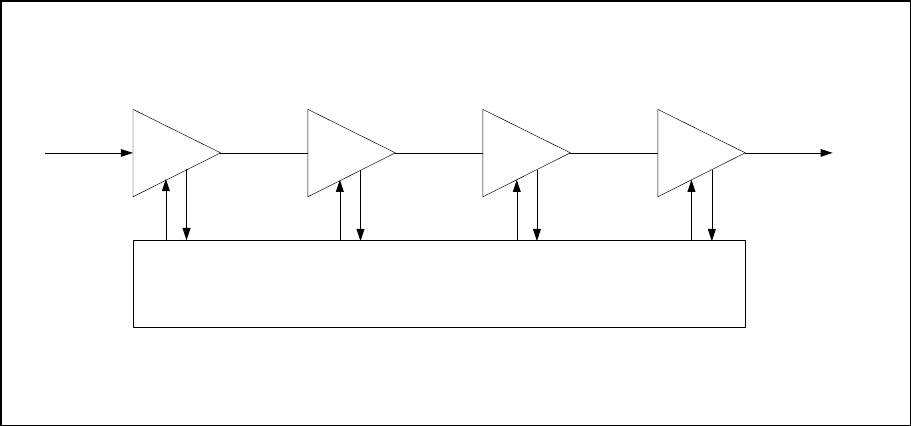
044-xxxxx Rev. x 4-2
4-4.3. DRIVER AMPLIFIER
The driver amplifier consists of two stages of class AB amplification which provide approximately
40 dB of gain in the 60 MHz frequency band from 1930 MHz to 1990 MHz. The amplifier operates
on +26 Vdc, and a safe bias voltage which is controlled by microprocessors.
4-4.4. MAIN AMPLIFIER
The main amplifier employs two class AB amplification stages for maximum efficiency. It provides
approximately 25 dB of gain in the 60 MHz frequency band. The output from the main amplifier is
typically 48.6 dBm. The amplifier operates on +26 Vdc, and gate bias voltages controlled by
microprocessors.
4-4.5. MULTIFUNCTION BOARD
The multifunction board consists of control and alarm circuits. The MCPA communicates to the
host system through the multifunction board which gathers the status information of the amplifier
and reports to the host system via the RS485 interface when instructed. It also protects the MCPA
from adverse conditions such as overpower, input overdrive, overvoltage, etc. A microprocessor
on the multifunction board also controls two loops in the feed-forward system.
4-5. AMPLIFIER MODULE COOLING
Each amplifier module is contained within a thermally conductive chassis which, when properly
mounted on an adequate thermal surface, will provide sufficient cooling to maintain the amplifier
within the specified operating temperature range.
4-6. POWER DISTRIBUTION
Primary DC power for the amplifier is provided by the host system. The amplifier generates all the
required voltages internally from the main source.
Figure 4-1. NTGY81AC Multichannel Power Amplifier Functional Block Diagram
RF
IN
INPUT
AMPLIFIER PREDISTORTION
AMPLIFIER DRIVER
AMPLIFIER MAIN
AMPLIFIER
RF
OUT
MULTIFUNCTION BOARD
(ALARMS AND LOOP CONTROLS)
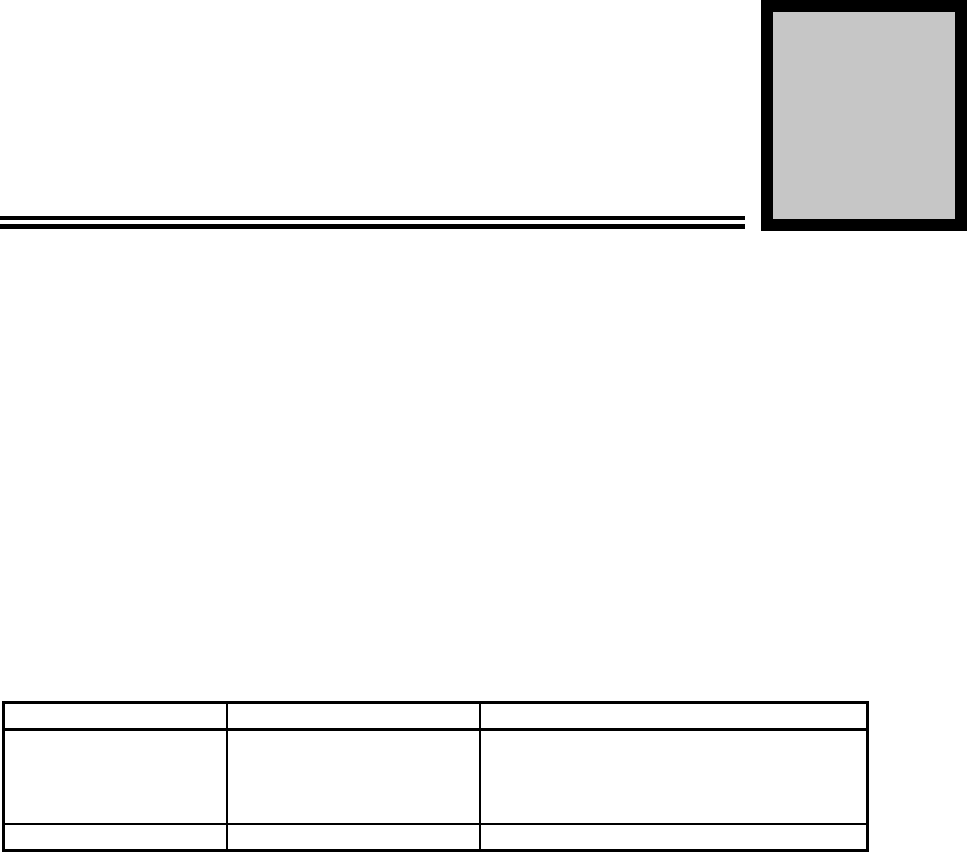
044-xxxxx Rev. x 5-1
MAINTENANCE
5-1. INTRODUCTION
This section contains periodic maintenance and performance test procedures for the multichannel
power amplifier. It also contains a list of test equipment required to perform the identified tasks.
NOTE
Check your sales order and equipment warranty
before attempting to service or repair the unit. Do
not break the seals on equipment under warranty or
the warranty will be null and void. Do not return
equipment for warranty or repair service until proper
shipping instructions are received from the factory.
5-2. PERIODIC MAINTENANCE
Periodic maintenance requirements are listed in Table 5-1. Table 5-1 also lists the intervals at
which the tasks should be performed.
Table 5-1. Periodic Maintenance
TASK INTERVAL ACTION
Inspection
Cables and
Connectors 12 Months Inspect signal and power cables for
frayed insulation. Check RF connectors
to be sure that they are tight.
Performance Tests 12 Months Perform annual test per paragraph 5-5.
5-3. TEST EQUIPMENT REQUIRED FOR TEST
Test equipment required to test the amplifier is listed in Table 5-2. Equivalent test equipment may
be substituted for any item, keeping in mind that a thermistor type power meter is required.
NOTE
All RF test equipment must be calibrated to 0.05
dB resolution. Any deviation from the nominal
attenuation must be accounted for and factored
into all output readings.
Section
5

044-xxxxx Rev. x 5-2
Table 5-2. Test Equipment Required
MENCLATURE MANUFACTURER MODEL
Signal Generator Agilent (H.P.) ESG4433B
30 dB Attenuator, 250 Watt Tenuline
Spectrum Analyzer H.P. 8562E
Coax Directional Coupler H.P. 778D
Power Meter / Sensor H.P. 437B / 8481A
Network Analyzer H.P. 8753D
Current Probe
Source Diskette Powerwave
Driver PA (1930-1990 MHz) 12 dB gain, P1dB = 29 dBm (min)
5-4. PERFORMANCE TEST
Performance testing should be conducted every 12 months to ensure that the amplifier system
meets the operational specifications listed in table 5-3. Also verify system performance after any
amplifier module is replaced in the field. The test equipment required to perform the testing is
listed in table 5-2, and the test setup is shown in figure 5-1.
5-4.1. AMPLIFIER PERFORMANCE TEST.
To perform the test, proceed as follows:
1. Connect test equipment as shown in figure 5-1.
NOTE
Do not apply any RF signals at this time.
AMPLIFIER SPURIOUS EMISSIONS TEST:
2. Load the MFRM waveform on the ESG (signal generator). Apply this signal through a
driver amplifier to the MCPA so that the RF signal going into the MCPA is approximately 0
dBm (adjust the input RF signal level to get 47 dBm output power). Measure spurious
emissions. Verify that it is within specification.
GAIN TEST:
3. Set input power level to power amplifier at 0 dBm (1932, 1960, and 1987 MHz).
4. Measure the output power in dBm.
5. Subtract input power (in dBm) from output power (in dBm) to get gain.
6. Check the amplifier gain across the band from 1930 MHz to 1990 MHz. Gain should be
47 ±2 dB. Record test data in table 5-3.
INPUT RETURN LOSS TEST:
7. Read and record the S11 return loss measurement on network analyzer. Record test data
in table 5-3.
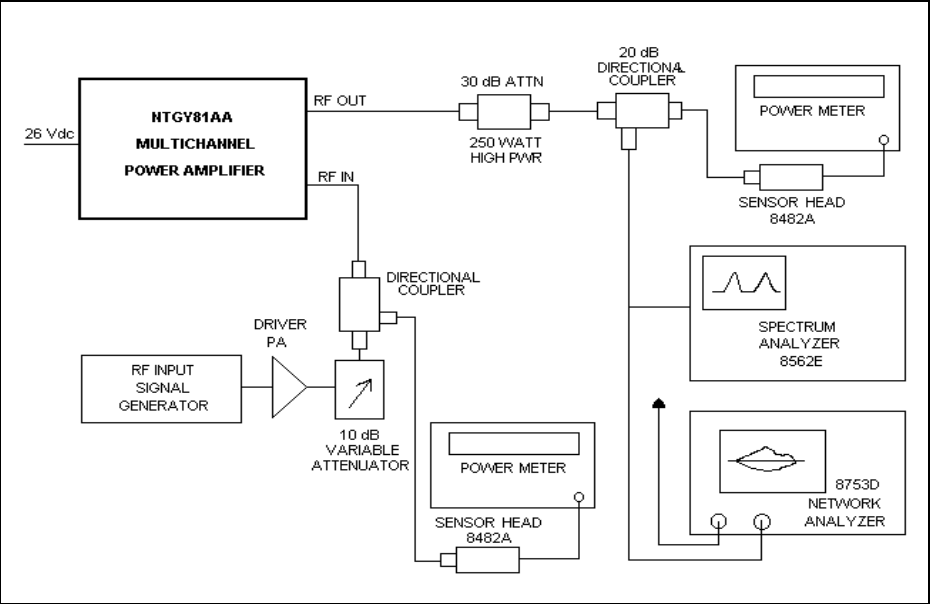
044-xxxxx Rev. x 5-3
Figure 5-1. NTGY81AC Amplifier Test Setup Diagram
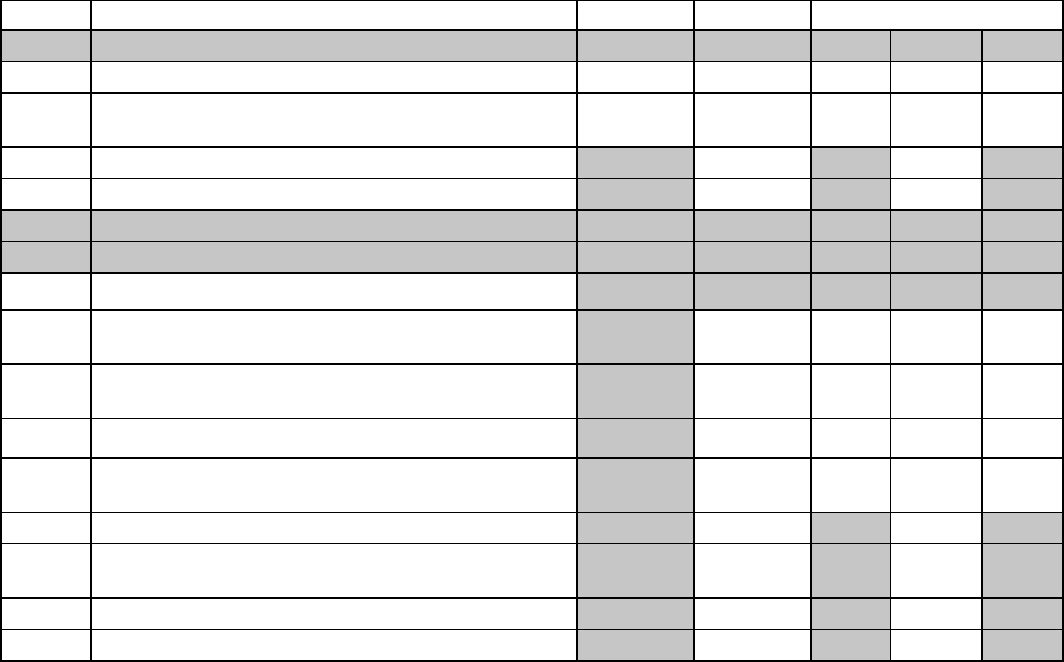
044-xxxxx Rev. x 5-4
Table 5-3. Multichannel Power Amplifier NTGY81AC Test Data Sheet
Tested By: ___________________ Serial No: ________________
Pass/Fail: ____________________ Date: ____________________
50W MCPA Test
Test Conditions: Load and source impedance: 50 ohms, VSWR < 1.2:1
Supply voltage: +26 Vdc ±
±±
± 0.4 Vdc (unless otherwise noted).
Network Analyzer Span: 60 MHz
Marker #1 = 1930 MHz, #2 = 1960 MHz, #3 = 1990 MHz
TEST CONDITION MIN MAX FREQUENCY (MHz)
1.00 NETWORK ANALYZER 1930 1960 1990
1.01 Gain 45.0 dB 49.0 dB
1.02 Gain Flatness 0 dB 0.4 dB/
1.25 MHz
1.03 Input Return Loss, worst case In band -10 dB
1.04 Output Return Loss, worst case in band -15 dB
2.00 CDMA TESTS (Spurious Emissions)
3 TONE: W-CDMA @ 50W out
RBW= 3KHz; VBW=10KHz
2.01 ∆ @ +2.25 Mhz -16 dBm/
1 MHz
2.02 ∆ @ –2.25 Mhz -16 dBm/
1 MHz
2.03 2nd Harmonic 3860 3920 3980
-16 dBm/
1 MHz
2.04 Pilot 1925 1945 1965
16 dBm/
1 MHz
2.05 Current @ 50 W out 19 A
044-xxxxx Rev. x 5-5
5-5. FIELD REPLACEMENT OF THE MODULE
The NTGY81AC multichannel power amplifier module can be replaced in the field on site by a
qualified technician with adequate ESD protection and experience maintaining RF power
amplifiers and similar equipment.
To replace a power amplifier module, proceed as follows:
1. Turn off 26 Vdc power to that specific module.
2. Disconnect the two RF cables and connectors P1 through P5.
3. Remove 13 screws that secure amplifier module to heat sink.
4. Carefully remove amplifier module from heat sink.
5. Add Thermstrate thermal interface pad to surface of replacement amplifier which
mates with heatsink.
6. Install replacement in reverse order of steps 1 through 4 above.
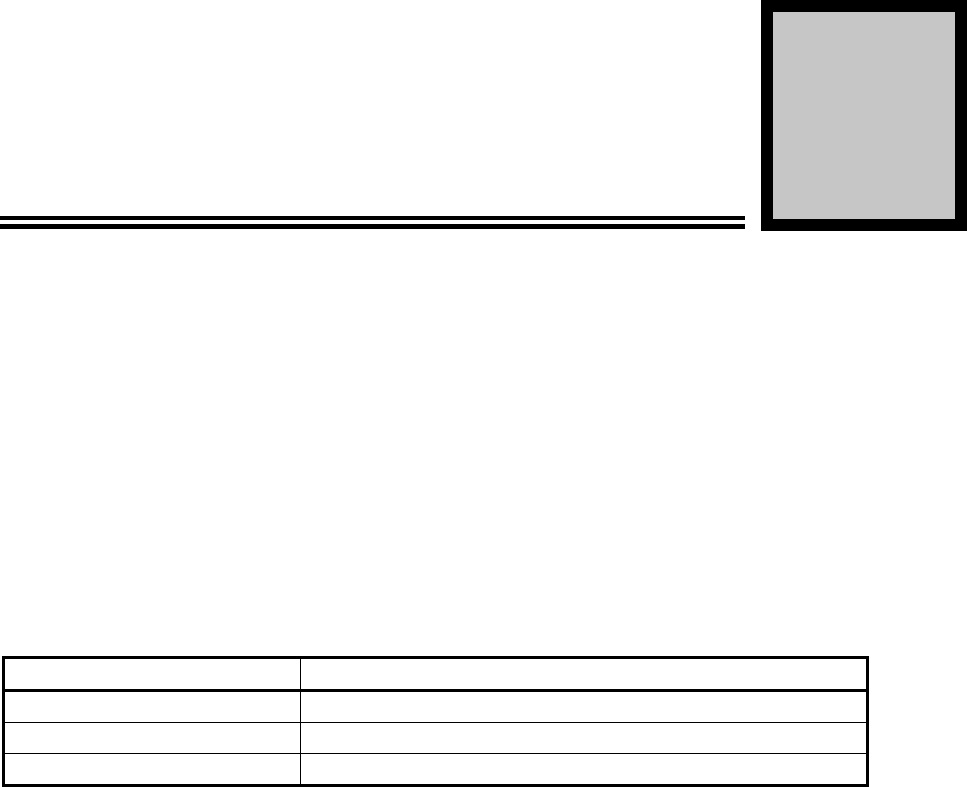
044-xxxxx Rev. x 6-1
TROUBLESHOOTING
6-1 INTRODUCTION
This section contains a list of problems which users have encountered and a few suggested
actions that may correct the problem. If the suggested corrective action does not eliminate the
problem, please contact your Powerwave field representative or the factory for further instructions.
NOTE
Check your sales order and equipment warranty
before attempting to service or repair the unit. Do
not break the seals on equipment under warranty or
the warranty will be null and void. Do not return
equipment for warranty or repair service until proper
shipping instructions are received from the factory.
6-2 TROUBLESHOOTING
Refer to table 6-1 for troubleshooting suggestions.
Table 6-1. Troubleshooting.
SYMPTOM SUGGESTED ACTION
MCPA Inoperative 1. Check for proper power supply voltage.
MCPA Not Enabled 1. Verify HPA-Allow-Enable line is high.
Alarm Output is (RS 422) High Verify input RF is within specified power and frequency limits
6-3 RETURN FOR SERVICE PROCEDURES
When returning products to Powerwave, the following procedures will ensure optimum response.
6-3.1 Obtaining an RMA
A Return Material Authorization (RMA) number must be obtained prior to returning
equipment to the factory for service. Please contact our Repair Department at (888) 797-
9283 or (714) 466-1000 to obtain this number, or FAX your request to (714) 466-5816.
Failure to obtain this RMA number may result in delays in receiving repair service.
6-3.2 Repackaging for Shipment
To ensure safe shipment of the amplifier, it is recommended that the package designed
for the amplifier be used. The original packaging material is reusable. If it is not
available, contact Powerwave’s Customer Service Department for packing materials and
information.
Section
6